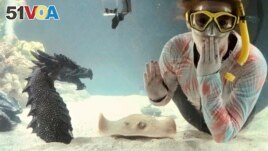Charlotte has spent much of her life in captivity at a non-profit aquarium in North Carolina's Appalachian Mountains. She is an ocean animal called a round stingray.
She is about 3,700 kilometers from her natural habitat in the Pacific Ocean off southern California. And she has not shared space with a male of her species in at least eight years.
But Charlotte is about to give birth. The reddish-brown stingray is pregnant with as many as four young, called pups. They were created by a rare process of natural reproduction called parthenogenesis. A female animal develops an egg into an embryo without fertilization material from a male.

Kinsley Boyette, assistant director of the Aquarium and Shark Lab by Team ECCO, poses in this undated photo next to Charlotte, a round stingray, in the American town of Hendersonville, North Carolina. (Aquarium and Shark Lab by Team ECCO via AP)
Charlotte will give birth to her young at home: Team ECCO Aquarium and Shark Lab on Main Street in Hendersonville. Brenda Ramer formed the organization and serves as its chief.
She said, when caretakers first noticed a lump on Charlotte's back, they thought it might be a cancerous growth. So, they examined the animal with an ultrasound machine, which makes images using sound. The images showed that Charlotte was pregnant.
The aquarium team was shocked.
"We were all like, ‘Shut the back door. There's no way,'" Ramer said. "We thought we were overfeeding her. But we were overfeeding her because she has more mouths to feed."
The small aquarium encourages local schoolchildren and others to take an interest in science. Now, they are getting a real-life lesson few witness. Parthenogenesis can happen in some insects, fish, amphibians, birds and reptiles, but it is extremely unusual. Documented examples have included California condors, Komodo dragons and yellow-bellied water snakes.
Kady Lyons is a research scientist at the Georgia Aquarium in Atlanta. She is not connected to the North Carolina aquarium. She said Charlotte's pregnancy is the only documented example of parthenogenesis in the round stingray that she knows of.
But Lyons is not shocked. Other kinds of rays, and related fish such as sharks, have had these kinds of pregnancies under human care.
"I'm not surprised, because nature finds a way of having this happen," she said.
To be clear, Lyons said, these animals are not cloning themselves. Instead, a female's egg joins with another cell in the female. This leads to cell division and creation of an embryo.
"We don't know why it happens," Lyons said. "Just that it's kind of this really neat phenomenon that they seem to be able to do."
Charlotte lives in a tank of about 8,300 liters of water. Ramer said the aquarium is hoping to get a tank nearly twice that size for Charlotte's young. They also want to put live cameras up for people to see them.
"It is very rare to happen," Ramer said. "But it's happening in the middle of the Blue Ridge Mountains in rural North Carolina, hundreds of miles from the ocean."
Round stingrays like Charlotte are common along the Pacific Ocean coasts of southern California and Mexico. They often rest on the ocean's sandy bottom near land.
In the wild, they are about the size of a food plate. They come in all shades of brown. They eat small animals like worms, crabs and mollusks. And round stingrays are sometimes eaten by sharks, seals and giant sea bass.
The round ray is well known to humans who like to go in the ocean. The ray can sting when stepped on.
Lyons finds the species fascinating.
"I'm glad the round stingray is getting the media attention that it deserves," Lyons said. "It's not necessarily as sexy as a white shark, but they do a lot of really neat stuff."
I'm Caty Weaver.
The Associated Press's Ben Finley wrote this report. Caty Weaver adapted it for VOA Learning English.
_____________________________________________
Words in This Story
aquarium –n. a tank that holds fish or a building that keeps fish for the public to see and enjoy
habitat –n. the environment in which a plant or animal lives
encourage –v. to cause someone to do something
cloning –n. the process of making an exact genetic copy of a living thing
phenomenon –n. an event that happens for a reason which can be described and studied
shade –n. the level of brightness or darkness that a color has
fascinating –adj. very interesting and worth attention
neat –adj. (informal) interesting or fun
